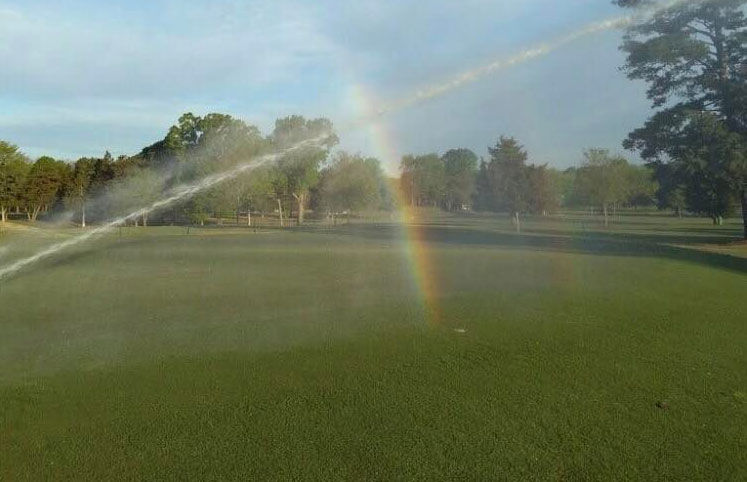

Follow the Way of the Sprinkler to Prevent Heat Stress
Warm season grasses are made for hot summers! These grasses, such as Bermuda, Centipede, and Zoysia, are from hot climates in Asia and Africa. They can withstand the baking heat of the Deep South, no problem.
It’s not soaring heat that causes warm season lawns to struggle, it’s lack of water. In fact, if you’re watering correctly, you shouldn’t see any signs of heat stress in your warm season lawn.
Cool season grasses, like Tall Fescue, do not enjoy the hot summers but thrive in cooler temperatures. Tall Fescue needs extra water, monthly fungicide, and to be mowed taller to help it thrive through the summer. More on that follows.
Armed with the tips below, we encourage you to become a student of your lawn and learn the way of the sprinkler to help your lawn thrive all summer long!
How to Water an Established Lawn
Follow these watering tips throughout the growing season, not just during soaring temperatures:
- Provide 1” of water a week for warm season lawns – all season long while the grass is green. That’s it! If it rains 1/2” in a week, turn on the irrigation to make up the remaining 1/2”.
- However, if you have TifTuf Bermuda as your lawn, you can turn off your irrigation without having to worry about loss of health or aesthetic quality, such as turning brown. It will continue to thrive through several months of drought.
- For Tall Fescue, a cool season grass, apply up to 2” of water a week during the height of summer and 1” of water the rest of the year. Also, apply fungicide monthly as a preventive treatment all summer.
- Water just before sunrise to reduce evaporation. More information on timing is in our article on How & When to Water Your Lawn.
- Don’t water in the evening or early in the morning. That timing will promote an unhealthy situation of water staying on the grass blades too long (all night, in fact). Turfgrass will stay healthier if it can dry out after watering, that’s why watering in the morning is best.
- Avoid water runoff – it wastes water and your grass doesn’t get any benefit. Water to before the point of runoff, then stop irrigation. Soil type and compaction can cause slow percolation which leads to runoff. Watch and study your lawn during irrigation. Test it even. If after half an hour runoff occurs, yet you haven’t applied 1” yet, then stop the irrigation. It’s okay to set your sprinkler to come on a few hours or days later to apply the remaining amount to reach 1 full inch.
Horticultural Tricks to Reduce Water Loss from Your Lawn
There are also horticultural methods to reduce water use and water loss in your lawn during the heat of summer. If you're interested in using less water, a little bit of prep and set up work will go a long way:
- Care for the Soil: Improve compacted soils by yearly aerating and topdressing with Soil³ humus compost. Aerating breaks up the soil, thereby allowing air, water, and compost to work down into compacted soils of the root zone. Applying Soil³ compost as a topdressing retains moisture and slowly supplies natural nutrients. Even in non-compacted soils, we recommend yearly aerating of all types of lawns.
- Sharpen Mower Blades: Sharp blades create a clean cut with less jagged edges . . . cleaner cuts sustain less water loss because there is less surface area . . . more surface area allows for more water loss. In short, sharpen your mower blades or buy replacements so your grass loses less water during the heat of the day.
- Investigate Robotics: A robotic lawn mower reduces water loss and lawn stress because it mows constantly. This constant mowing only cuts tiny snippets off at a time compared to mowing every 7-10 days and cutting larger amounts which can increase stress. Plus, the blades are razor sharp. The clean cut of the robot’s blades, plus the constant, gentle snipping are much easier on a lawn. And, let’s be real, many folks skip a week here and there and mowing of too-tall grass is a shock to the lawn.

How to Tell if Your Established Lawn is Dry
Yes, you can tell just by looking! However, I hope you're watering your lawn before it shows the following symptoms.
- Curled Blades: Blades curl inward along the entire sides of the blades, from base to tip – basically curling into a tiny tube.
- Color Change - Changes in Green: If your green lawn slightly changes to a lighter hue or a blue-green tint that is different than the typical green color, then your lawn is getting too dry. Indeed, when you become a student of your lawn, you’ll start to recognize color changes!
- Color Change - Grey or Brown: If areas of your warm season lawn turn grey or light brown, it is going dormant due to heat stress and drought. Various conditions can cause heat stress in some areas more than others: places that receive more direct sun; compacted soil or rocks beneath the grass; heat transfer from concrete paths or driveways; tree roots that compete for water; reflection of sun from windows; slopes that have more runoff and reduced water absorption. The good news is warm season lawns will green up when rains return or when you turn on your irrigation. But, really, do we want to go this far and let it go temporarily dormant? Nope.
- Color Change - Brown: If your Tall Fescue lawn turns brown in the summer, plan to reseed or re-sod come September.
For the love of your lawn, please avoid any phase of drought stress! Set up a weekly schedule of watering. Don’t wait until you see the signs. Regular watering also prevents diseases, such as bipolaris.
How to Avoid Heat Stress when Laying Sod
Warm season grasses don't miss a beat when planted on hot days, as long as you follow take care of it. Follow these pointers and all you'll see is green.
- Place pallets in the shade while you lay the sod.
- Water as you go. After you lay a row, hose it down. Then lay the next row. In high heat, you have no wiggle room with this step. It’s serious business and you need to water right away.
- Water the entire lawn when you have completed installation.
- Don’t lay Tall Fescue sod in the late spring or summer. It simply doesn’t work. The window for laying Tall Fescue sod in the coolest areas of the Southeast (plant hardieness Zones 8a and cooler) is typically from September through April.
- After the new sod is laid, follow our watering instructions to ensure successful establishment of the root system . . . and happy, green grass! Basically, keep new sod "wet like a sponge" (this may mean daily or 3x daily watering) until roots form and you can hardly pull it up.
The first sign that your new sod isn't getting enough water each day is brown edges along each roll. Then brown patches indicate that the problem is getting worse. The cure: more water over the whole lawn!
Alternatives to the Sprinkler - Drought Tolerant TifTuf
For a second “way,” consider switching to TifTuf Bermuda. Its strengths are legendary, mainly because of its drought tolerance. Does the way of the sprinkler not fit your budget? Learn how TifTuf saves water and saves money.
Tifway Bermuda (left) vs. TifTuf Bermuda (right).
TifTuf is still green under drought conditions, Fall 2017.






